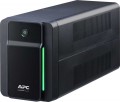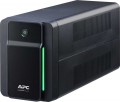Redundant sockets
The number of
outlets connected to the power reserve(battery) provided in the design of the UPS. In order for the UPS to fulfill its main role (providing a backup power in case of power outages), the corresponding electrical appliances must be connected to these outlets. The sockets have a standard shape and are compatible with the vast majority of popular 230 V plugs.
At a minimum, the UPS has
1 or
2 outlets and, in more advanced ones, there may be
3 or
more.
Socket type
A socket for a specific type of plug in the UPS design.
—
Type F (Schuko). A traditional European socket with two round holes in the center and grounding contacts in the form of two metal brackets (at the top and bottom of the socket). The term Schuko stuck to this type of socket due to the abbreviation from the German Schutzkontakt - protective contact.
—
Type E (French). The French style socket has two round holes and a protruding ground pin just above them in the center. The standard has become widespread in France, Poland and Belgium (along with the traditional type F sockets).
—
Type G (British). The plug for such sockets consists of two flat horizontal pins and one flat vertical pin for grounding. The standard is found mainly in the countries of the United Kingdom, Malta, Cyprus, Singapore and Hong Kong.
—
Type B (American). American-style sockets are designed for plugs with two flat prongs and a semicircular grounding contact. Type B is widely used in regions with voltage 110 - 127 V - USA, Japan, Saudi Arabia, etc.
Reserved C13/C14 connectors
Number of
C13/C14 connectors with power reserve provided in the UPS design.
Electrical appliances connected to connectors with a reserve are insured against a power failure in the network - in this case they switch to the battery. The C13/C14 connector itself is also known as a “computer socket”; it supplies the same 230 V as a regular household network, but is not compatible with plugs for traditional sockets, because uses three flat contacts. However, there are adapters between these standards.
At a minimum, the UPS is provided with
1,
2 or
3 C13/C14 connectors for one workstation. In more advanced, so to speak office ones, the number of C13/C14 connectors may be greater -
4 ports,
6 connectors,
8 and even more
1st battery voltage
The value of the operating voltage of one complete battery. In most cases, it is 12 V, UPS with 24-volt batteries is a little less common.
Battery type
The type of battery installed in the UPS.
—
Fiberglass (AGM). An advanced type of lead-acid battery with electrolyte in an adsorbed state: the compartments of such a battery are filled with porous material, which contains acid. At the same time, the battery case is sealed and AGM models are maintenance-free. This technology is the most popular in batteries for uninterruptible power supplies: it is ideal for batteries operating in buffer mode (that is, when they rarely need to be discharged and, as a rule, little by little). In addition, it provides a long service life, and AGM batteries are inexpensive. The disadvantages of this option include the impossibility of replenishing the electrolyte if it leaks, as well as poor tolerance to overcharging (although the latter becomes irrelevant with a high-quality power controller).
—
Gel (GEL). A type of lead-acid battery that uses a gel electrolyte. GEL batteries are best suited for operation in cyclic mode - that is, when the battery needs to power the load for a long time, discharge almost to zero, then charge and again provide long-term autonomous power. But for the buffer mode, in which most UPSs operate (standing on standby for a long time in order to briefly maintain power supply in the event of a failure), this technology is not suitable for a number of reasons. Therefore, it makes sense to purchase such batteries only in cases where t
...he “uninterruptible power supply” has to be turned on almost every day - for example, in unstable networks with constant and long-term power outages.
— Lithium-ion (Li-Ion). The key advantages of lithium-ion batteries are high capacity with small dimensions and weight. Also, Li-Ion batteries are not subject to the “memory effect” and can charge quite quickly. Of course, this option is not without its drawbacks - first of all, it is sensitive to low and high temperatures, and if overloaded, the lithium-ion battery can catch fire or even explode. However, thanks to the use of built-in controllers, the likelihood of such “emergency” situations is extremely low and, in general, the advantages of this technology significantly outweigh the disadvantages.
— Lithium iron phosphate (LiFePO4). An advanced modification of lithium-ion batteries (see above), designed to eliminate some of the shortcomings of the original technology. Lithium iron phosphate batteries are characterized by a large number of charge/discharge cycles, chemical and thermal stability, low temperature tolerance, short charging time (including high currents) and safety in operation. The likelihood of an “explosion” of a LiFePO4 battery when overloaded is reduced to almost zero, and in general, such batteries cope with high peak loads without problems and maintain the operating voltage almost until they are fully discharged.Fuse
Fuses are used to protect the UPS from a critical increase in current strength: at the right time, they open the circuit, preventing unpleasant consequences. Today, these types of fuses are used.
— Melting. At a critical current strength, the conductive element in such a fuse melts and opens the circuit. The fusible protection is disposable, after operation such a fuse must be replaced.
— Automatic. Such a fuse has a sensor that monitors the current strength and opens the contacts at the right time. Its main difference from fusible is reusability: after operation, the circuit can be closed again with literally one press of the button on the fuse.

